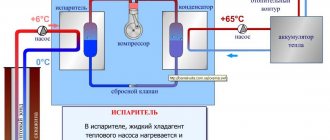Advantages and disadvantages of geothermal power plants
Advantages of Geothermal Power Plants
- Geothermal energy reserves are large, although not infinite. It can be considered a renewable energy source - at least as long as it doesn't pump too much water into the injection well in too short a time.
- A geothermal power plant does not require fuel supplies from external sources to operate.
- The operation of geothermal power plants is not accompanied by harmful or toxic emissions (see, however, the third disadvantage of geothermal power plants below).
- In addition to the external energy source required for the first start of the pump (or pumps), geothermal power plants do not need external energy (fuel) for further operation. Once a geothermal power plant starts operating, its pumps can be powered by electricity generated at the plant itself.
- There are no additional costs to operate a geothermal power plant other than preventative maintenance or repairs.
- Geothermal power plants do not spoil the landscape and do not require significant land acquisition.
- A conventional geothermal power plant located on the seashore or ocean can also be used to desalinate water, which can then be used for drinking or irrigation. Desalination occurs naturally as a result of distillation - heating water and cooling water vapor during the operation of a power plant.
Disadvantages of Geothermal Power Plants
- Finding a suitable location for a geothermal power plant and obtaining local government approval and community consent can be challenging.
- Sometimes an operating geothermal power plant may shut down as a result of natural changes in the earth's crust. In addition, the reason for its stopping may be poor choice of location or excessive injection of water into the rock through an injection well.
- A production well may release flammable or toxic gases or minerals contained in the earth's crust. Getting rid of them is quite difficult. True, in some cases they can be siphoned (collected) and processed into fuel (crude oil or natural gas, for example).
Is it possible to build a small geothermal power plant that can provide electricity to a home or small village?
This can be done in areas where deep, expensive wells do not need to be drilled. The most significant example is perhaps Iceland, which is essentially located on top of a giant volcano. In the United States, such areas include the areas around Yellowstone, Thermopolis and Saratoga in Wyoming and around the city of Hot Springs in South Dakota (In Russia, Kamchatka is considered the most famous region with high potential for geothermal energy.).
Disadvantages of Geothermal Power Plants
- The development, design and construction of such stations require significant investments at the initial stage .
- Difficulties often arise in choosing a suitable location for building a power plant and obtaining permission from local authorities .
- The operation of the stations is accompanied by a significant level of noise , as a result of which it is not recommended to build them near populated areas.
- Combustible and toxic gases contained in the earth's crust can reach the surface through a working well. Some modern plants collect these emissions and convert them into fuels such as crude oil or natural gas.
- Sometimes it is possible to stop a running station . This is usually caused by natural processes in the rock or by excessive pumping of water into the well.
- As a rule, such power plants are built in places where geothermal sources come to the surface . These sources are directly related to the tectonic faults of the planet. Taking into account the difficulty of predicting seismic activity, it is easy to conclude that such areas are far from the most favorable place for the construction and subsequent operation of a power plant.
Pros and cons of geothermal energy
The power of the Earth's geothermal waters is an alternative source of energy. This method of generating energy is used in regions where geothermal sources come to the surface or are located in places of easy reach. Before constructing a station at the site of the sources, the perimeter is assessed from the point of view of engineering and economic feasibility, and most importantly, safety. Turbines of geothermal plants drive steam, which is released by geysers and volcanoes
It follows that geothermal sources are usually located in unstable seismic zones, which means safety is a matter of paramount importance
Prospects and benefits of geothermal energy
The construction scheme of the future Geothermal Power Plant, which converts the energy of the Earth's geothermal waters into electricity, depends on the source on which the station will be built. Sometimes the engineering idea comes down to simply drilling a well, and sometimes additional equipment and technology are required to clean the steam from harmful exhausts or solid particles. The principle of extracting electricity from sources is simple: steam rises up the well, driving turbines, and then returns back to the casing.
Geothermal stations are actively used on an industrial scale, agricultural activities, and housing and communal services. With their help, greenhouses, greenhouses, and various aqua installations are heated and watered. Underground springs are used to irrigate fields or maintain the required level of humidity for growing crops. Geothermal power plants are successfully used in housing and communal services, replacing traditional power plants. The largest geothermal power plant was built in Kenya. It supplies enough electricity to run the city.
Geothermal Energy Sources: Pros and Cons
The main disadvantage of geothermal energy lies in the very origin of the energy: stations are built in seismically active zones. The problem is that predicting the awakening of a volcano, earthquake or soil movement is not an easy task. Construction of a station in such places always involves risks. And taking into account the fact that the construction of geothermal power plants is a costly matter, the question arises about the feasibility of using the power of the Earth’s geothermal waters. To avoid risks, “quiet” regions are selected for the construction of geothermal power plants, where the last seismic activity was noticed only in the distant past. Exploration for potential deposits is underway in more than seventy countries. For example, in Russia these are the Stavropol Territory, Kamchatka, Sakhalin. In Ukraine - Transcarpathia, Odessa region, Kherson.
Advantages:
- Impressive reserves of geothermal energy. One of the main advantages of geothermal energy is that, if used properly, this source can be called renewable.
- Saving on fuel. The geothermal power plant does not require additional fuel supplies for its operation.
- Environmentally friendly. Geothermal sources and the stations that operate them do not emit harmful substances. And those harmful substances that may arise during energy production are collected and processed (for example, oil or natural gas).
- Self-sufficiency. Additional fuel from third-party sources is required only for the first start-up of the station. In the future, the geothermal power plant can provide electricity to itself. It is produced enough for supplies and for self-sufficiency.
- Economical operation. The station does not require large expenses for its operation - only for scheduled maintenance, repairs and prevention.
- Additional benefit. If a power plant is located on the seashore, it can be used to desalinate water. Water is distilled by heating and cooling steam during the operation of the geothermal power plant. In the future, this water can be used for drinking or artificial irrigation of land.
- Aesthetic appearance. Geothermal power plants do not spoil the landscape, do not require large land allocations, and modern projects even add aesthetic completeness to the appearance.
Flaws:
- Difficulties in approving the project. Problems arise at all stages of design: finding a suitable location, testing, obtaining permission from the authorities and the local population.
- Stop work at any time. It is difficult to predict a volcanic eruption or earthquake. The station's operation may stop even due to natural changes in the earth's crust. An unsuccessful choice of location for the construction of a geothermal power plant also does not contribute to long-term stable operation. Another reason for stopping is exceeding the norm for pumping water into the rock.
- If source emissions are not filtered, harmful substances may be released into the environment.
Prospects and benefits of geothermal energy
The complexity of building a geothermal power plant, which converts water into electricity, largely depends on the territory on which this structure will be built. In some cases, only drilling a well is sufficient, and in some cases it is necessary to install auxiliary equipment and apply technology for purifying steam from harmful substances.
The advantage of geothermal power plants is that they are used as a new power source. There are 3 ways to use this natural resource:
- Direct method. Its operating principle is the use of dry steam, which drives turbines and a generator that generate electricity.
- Indirect method. It involves the use of water vapor, as well as an evaporator that uses a hydrothermal mixture. Evaporation helps reduce pressure, and because of this, the turbines of the power plant begin to work.
- Mixed method. It consists of using water and additional liquid. When hydrothermal water interacts with liquid, a large production of steam occurs, causing turbines to work. After this, the process of steam transition to condensation occurs for further heating. This operating principle makes it possible not to worsen the environmental situation, since this system does not release harmful substances into nature.
GeoPPs are often used in industry, agriculture, housing and communal services, etc. These structures heat and water greenhouses, greenhouses, and aqua structures. In addition, geothermal energy maintains the required level of humidity, which is especially important for growing various crops in large volumes. In the housing and communal services sector, such a source of energy production has replaced the outdated type of conventional power station.
The largest power plant of this type is located in Kenya. It allows you to generate enough electricity for the entire city.
Next, we will look in detail at the pros and cons of geothermal energy sources.
Calculations
The main parameters that are taken into account in any calculations are:
- temperature (depths from 15-20 m or more warm up from 8 to 100 degrees, depending on the conditions);
- extracted power value (average value - 0.05 kW per 1 m);
- the influence of climate, humidity and contact with groundwater on heat transfer.
Interesting Construction waste
What is very interesting is that completely dry rocks emit no more than 25 W per 1 m, and if there is groundwater, this figure rises to 100-110 W. We must not forget that the standard operating time of a heat pump is 1800 hours per year. If you exceed this figure, the system will not become more efficient, but its wear will rapidly increase. What is much worse, excessive exploitation of the thermal resource of the subsoil leads to its cooling and even to the freezing of rocks at the working depth. Following this, the soil may subsidence, sometimes damaging working pipes and above-ground structures.
Advantages of Geothermal Power Plants
- Geothermal energy reserves are large, although not infinite. It can be considered a renewable energy source - at least as long as it doesn't pump too much water into the injection well in too short a time.
- A geothermal power plant does not require fuel supplies from external sources to operate.
- The operation of geothermal power plants is not accompanied by harmful or toxic emissions (see, however, the third disadvantage of geothermal power plants below).
- In addition to the external energy source required for the first start of the pump (or pumps), geothermal power plants do not need external energy (fuel) for further operation. Once a geothermal power plant starts operating, its pumps can be powered by electricity generated at the plant itself.
- There are no additional costs to operate a geothermal power plant other than preventative maintenance or repairs.
- Geothermal power plants do not spoil the landscape and do not require significant land acquisition.
- A conventional geothermal power plant located on the seashore or ocean can also be used to desalinate water, which can then be used for drinking or irrigation. Desalination occurs naturally as a result of distillation - heating water and cooling water vapor during the operation of a power plant.
Environmental and technical problems of the industry
The development of geothermal energy is significantly hampered by a number of problems inherent in this industry. Among the most serious obstacles is the need for a complex process of reinjecting waste coolant (water) containing toxic substances into aquifers - arsenic, cadmium, zinc, lead, boron. This eliminates the possibility of releasing such water into the surface layers. In addition, the problem of hydrogen sulfide emissions into the atmosphere is acute.
For geothermal stations, among other things, unlike thermal power plants and even hydroelectric power plants, there is a strict binding of the construction site to certain areas depending on the geology. Often (except perhaps Iceland), such places are located in hard-to-reach areas, mountainous areas. One should not discount the high mineralization of groundwater, which over time leads to clogging of wells.
It is necessary to take into account the main development factor inherent in any industry - market demand. OPEC calculated that, despite the overall increase in demand for renewable energy resources, including geothermal, by 7.6% per year, by 2040 the share of such sources in energy production will be only 4.3%, inferior to traditional methods generation
Currently, the share of alternative energy is only 0.9% on the world market.
Difficulties and problems of operating a geothermal power plant:
– the need for a renewable cycle of supply and reinjection of waste water into the underground aquifer, which requires additional energy consumption. Injection of waste water is also necessary to ensure that the pressure in the aquifer does not drop, which will lead to a decrease in the output of the geothermal station or its complete inoperability;
– thermal waters contain a large amount of salts of various toxic metals (for example, lead, zinc, cadmium), non-metals (for example, boron, arsenic) and chemical compounds (for example, ammonia, phenols, hydrogen sulfide, methane), which excludes the discharge of these waters into natural water systems located on the surface, on the one hand, and which negatively affect the operation of equipment, on the other, and therefore are subject to extraction and disposal.
Geothermal power plant structures
Geothermal energy is clean, sustainable heat from the Earth. Great resources are found in a range of several kilometers below the earth's surface, and even deeper, to high temperature molten rock called magma. But as described above, people have not yet reached the magma.
Almost everywhere, in shallow places below 3 meters from the surface, the earth has an almost constant temperature of 10° to 16°C. Geothermal heat pumps can use this resource to heat or cool buildings.
A geothermal heat pump system consists of a heat pump, an air delivery system (ducts), and a heat exchanger - a system of pipes located in shallow areas near the building. During the winter, the heat pump extracts heat from the heat exchanger and supplies it to the indoor air supply system. In summer the process is reversed and the heat pump transfers heat from the indoor air to the heat exchanger. Heat removed from indoor air during the summer can also be used to provide a free source of hot water.
Some geothermal power plants use steam from a reservoir to spin a generator turbine, while others use hot water to boil a working fluid that evaporates and then spins the turbine. Hot water near the Earth's surface can be used directly for heat. Direct uses include heating buildings, growing plants in greenhouses, drying crops, heating water in fish farms, and a number of industrial processes such as milk pasteurization.
Structure of geothermal power plants
Traditional geothermal energy is a mature technology that can provide baseload power or year-round heating. The resource can only be used in favorable regions. Matching thermal energy demand with available resources can be challenging given the cost and difficulty of transporting heat over long distances.
Currently, the most common way to harness energy from geothermal sources is through natural "hydrothermal convection" where water percolates through the Earth's crust, is heated, and then rises to the surface. The heated water is then used to drive electrical generators.
There are three main designs for geothermal power plants:
- In the simplest design, dry steam passes directly through turbines and then through a condenser, where the steam is condensed into water.
- In the second approach, very hot water is converted into steam, which can then be used to drive a turbine.
- In a third approach, called a binary system, hot water passes through a heat exchanger where it heats a second liquid—such as isobutane—in a closed loop. Isobutane boils at a lower temperature than water, so it is more easily converted into steam to run a turbine.
Three designs of geothermal power plants
The technology of application is determined by the resource. If the water comes from the well as steam, it can be used directly. If hot water is at a high enough temperature it must pass through a heat exchanger.
Direct use of geothermal heat
Geothermal sources can also be used directly for heating purposes. Hot water is used to heat buildings, grow plants in greenhouses, dry fish and crops, improve oil recovery, aid in industrial processes such as milk pasteurizers, and heat water in fish farms. In the United States, Klamath Falls, Oregon and Boise, Idaho, have used geothermal water to heat homes and buildings for over a century. On the East Coast, Warm Springs, Virginia gets its heat directly from spring water using heat sources at one of the local resorts.
In Iceland, almost every building in the country is heated by hot spring water. In fact, Iceland gets more than 50 percent of its primary energy from geothermal sources. In Reykjavik, for example (population 118 thousand), hot water is conveyed by conveyor over 25 kilometers, and residents use it for heating and natural needs.
New Zealand receives an additional 10% of its electricity. Geothermal energy in Russia is underdeveloped, despite the presence of thermal waters.
Geothermal power plants (GeoTES). Status and development prospects
Geothermal power plant (GeoPP or GeoTES) is a type of power plant that generates electrical energy from thermal energy from underground sources. The contents of geothermal power plants are shown in Fig. 3, 4.
Currently, direct and binary schemes for constructing geothermal power plants are used.
When using a direct scheme (Fig. 5), steam directly from the well or steam obtained in a separator from hot groundwater is sent through pipes to turbines connected to electric generators.
Rice. 3. Geothermal power plant structure: 1 – reservoir; 2 – pumping station; 3 – heat exchanger; 4 – turbine hall; 5 – production well; 6 – injection well; 7 – hot water for heating; 8 – porous sedimentary rock; 9 – observation well; 10 – crystalline bedrock
Rice. 4. General view and diagram of geothermal power plant equipment
Rice. 5. Geothermal power plant with a direct construction scheme
In the binary scheme of thermal power plants, not thermal water or steam is used as a working fluid, but another liquid with a low boiling point (Fig. 6). The thermal water is passed through a heat exchanger, where steam from another liquid (hydrocarbon isobutane) is generated, which is used to rotate the turbine.
Rice. 6. Binary scheme of thermal power plant
As can be seen from Fig. 7, the equipment of a binary GeoTPP unit includes various tanks, pipelines, pumps, heat exchangers, etc.
Geothermal thermal power plants can be effectively used for both heating and electricity production (Fig. 8).
As can be seen from Fig. 9 Geothermal power plants are most widely used in the USA, the Philippines and Indonesia (for example, in the USA the installed capacity of geothermal power plants is more than 3.5 GW (Fig. 9)).
Rice. 7. General view of the equipment of the geothermal power plant binary unit
Rice. 8. Scheme of using a block binary geothermal power plant to generate heat and electricity
The first geothermal station was created in our country in Brest (greenhouse complex “Berestye”, 1520 m, 40 °C, 1.0 mW) (Fig. 10). The disadvantage of geothermal waters in Belarus is the high content of salt impurities, which requires their purification before use, and, accordingly, leads to an increase in cost.
Rice. 9. World leaders in the use of geothermal energy
Rice. 10. General view of GeoThermal Power Plant (greenhouse complex “Berestye”)
Advantages and disadvantages
Advantages
The main advantage of geothermal energy is its practical inexhaustibility and complete independence from environmental conditions, time of day and year.
There are the following fundamental possibilities for using the heat of the earth's depths. Water or a mixture of water and steam, depending on their temperature, can be used for hot water supply and heating, for generating electricity, or for all these purposes simultaneously. The high-temperature heat of the perivolcanic region and dry rocks is preferably used for electricity generation and heat supply. The design of the station depends on what source of geothermal energy is used.
Interesting Waste and garbage disposal in Moscow and the Moscow region, affordable cost of disposal of household and construction waste, price
If there are sources of underground thermal waters in a given region, then it is advisable to use them for heat supply and hot water supply. Large reserves of underground thermal waters are found in Dagestan, North Ossetia, Chechnya, Ingushetia, Kabardino-Balkaria, Transcaucasia, Stavropol and Krasnodar territories, Kamchatka and a number of other regions of Russia, also in Kazakhstan.
Flaws
In order to convert thermal energy into electrical energy using some kind of heat engine (for example, a steam turbine), it is necessary that the temperature of the geothermal waters be high enough, otherwise the efficiency of the heat engine will be too low (for example, at a water temperature of 40° C and an ambient temperature of 20°C, the efficiency of an ideal heat engine will be only 6%, and the efficiency of real machines is even lower; in addition, part of the energy will be spent on the station’s own needs - for example, on the operation of pumps that pump coolant from the well and pump in cooled coolant back). To generate electricity, it is advisable to use geothermal water with a temperature of 150°C and above. Even for heating and hot water supply a temperature of at least 50°C is required. However, the Earth's temperature increases rather slowly with depth; usually the geothermal gradient is only 30°C per 1 km, i.e. Even for hot water supply, a well more than a kilometer deep will be required, and for generating electricity - several kilometers. Drilling such deep wells is expensive; in addition, pumping coolant through them also requires energy, so the use of geothermal energy is not practical everywhere. Almost all large GeoPPs are located in places of increased volcanism - Kamchatka, Iceland, the Philippines, Kenya, California (USA), etc., where the geothermal gradient is much higher and geothermal waters are close to the surface.
One of the problems that arise when using underground thermal waters is the need for a renewable cycle of supply (injection) of water (usually waste) into the underground aquifer, which requires energy consumption. Thermal waters contain large amounts of salts of various toxic metals (for example, lead, zinc, cadmium), non-metals (for example, boron, arsenic) and chemical compounds (ammonia, phenols), which excludes the discharge of these waters into natural water systems located on the surface . Injection of waste water is also necessary to ensure that the pressure in the aquifer does not drop, which will lead to a decrease in the output of the geothermal station, or its complete inoperability.
Of greatest interest are high-temperature thermal waters or steam outputs, which can be used for electricity production and heat supply.
What are the main advantages and disadvantages of geothermal energy
This method of obtaining energy has a number of obvious advantages.
- GeoPPs do not require fuel, the reserves of which are limited.
- All operating costs are reduced to the costs of regulated work on the planned replacement of components.
- They do not require additional energy for technological needs. Additional equipment is obtained from extracted resources.
- It is possible to simultaneously desalinate sea water (If the station is located on the sea coast)
- Conventionally considered environmentally friendly. Because most of the shortcomings are tied to issues of environmental friendliness of objects.
If you look carefully at the photographs of the Mutnovskaya hydrothermal station, you will be surprised. No dirt or grime, neat, clean bodies with clouds of white steam. But not everything is so wonderful. Geothermal power plants have their drawbacks.
- When located near populated areas, residents are disturbed by the noise produced by the enterprise.
- Building the station itself is expensive. And this affects the cost of the final product.
- It is difficult to predict in advance what will come out of a well in deep layers: mineral water (not necessarily healing), oil or toxic gas. And these are issues of public safety. Of course, it would be great if geologists stumble upon a layer of minerals while drilling. But this discovery can completely change the way of life of the population. Therefore, local authorities are reluctant to give permission even for survey work.
- Difficulties arise with choosing a location for the future GeoPP. After all, if the heat source loses its energy potential over time, the money will be wasted. In addition, ground failures are possible in the station area.
Pros and cons of this energy source
Geothermal energy has two main advantages: inexhaustibility and independence from external factors. The installed capacity factor can reach up to 80 percent. However, the following disadvantages cannot be ignored:
Economic importance of wells. To convert heat, it is necessary that the temperature value of the water be sufficient. To do this, wells are drilled deeper. But since the temperature gradient is most often small, you have to drill at least a kilometer in length, which is not economically profitable;
Environmentally friendly. The exploitation of groundwater is problematic, since it contains compounds of toxic elements (metals and non-metals), so it cannot be thoughtlessly dumped on the surface, it must be pumped back
It is also important for maintaining aquifers;
Provoking earthquakes. Electricity extraction activities in a seismically hazardous area can lead to an earthquake
For example, like in Pohang in 2021.
vote
Article Rating
Geothermal energy advantages and disadvantages
Among all the alternative sources, geothermal energy ranks high on this list. These power plants are placed on surfaces within close reach.
When constructing such a structure, the advantages and disadvantages of geothermal energy, as well as its safety, are taken into account. In addition, when constructing this structure, you need to choose those areas where seismic activity is observed. These areas must have hot springs. Since the water in them can heat up to high temperatures due to the activity of volcanoes or geysers.
To better learn about this source of electrical energy production, we will take a detailed look at the advantages and disadvantages of geothermal power plants, as well as the prospects for their use.
Story
In 1817, Count François de Larderel developed a technology for collecting steam from natural geothermal sources. In the 20th century, the demand for electricity led to the emergence of projects to create power plants that harness the Earth's internal heat. The man who tested the first geothermal generator was Piero Ginori Conti. This happened on July 4, 1904 in the Italian city of Larderello. The generator was able to successfully light four light bulbs. Later, in 1911, the world's first geothermal power plant was built in the same locality, and it is still in operation. In the 1920s, experimental generators were built at Beppu (Japan) and the California Geysers, but Italy was the world's only industrial producer of geothermal electricity until 1958.
Top five countries in geothermal energy production, 1980–2012 (US EIA)
GeoPP capacity growth by year
In 1958, when the Wairakei Power Station came online, New Zealand became the second major industrial producer of geothermal electricity. Wairakei was the first indirect station. In 1960, Pacific Gas and Electric began operating the first successful geothermal power plant in the United States at the California Geysers. The first binary geothermal power plant was first demonstrated in 1967 in the Soviet Union and then introduced to the United States in 1981, following the 1970s energy crisis and significant changes in regulatory policy. This technology allows the use of much lower temperatures to produce electricity than previously. In 2006, a binary cycle plant began operating in China Hot Springs, Alaska, producing electricity with a record low liquid temperature of 57 °C. Until recently, geothermal power plants were built exclusively where there were high-temperature geothermal sources near the surface. The advent of binary cycle power plants and improvements in drilling and production technology may encourage the emergence of geothermal power plants over a much larger geographic range. Demonstration power plants are in the German city of Landau in der Pfalz and the French city of Soulz-sous-Forêt, while earlier work in Basel, Switzerland was closed after it caused earthquakes. Other demonstration projects are under development in Australia, the United Kingdom and the United States of America.
The thermal efficiency of geothermal power plants is low, around 7–10%, because geothermal fluids have a lower temperature than steam from boilers. According to the laws of thermodynamics, this low temperature limits the efficiency of heat engines in extracting useful energy when generating electricity. Waste heat is wasted unless it can be used directly, such as in greenhouses or district heating. System efficiency does not affect operating costs as it would for a coal or other fossil fuel plant, but it is a factor in the viability of the plant. To produce more energy than the pumps consume, high-temperature geothermal sources and specialized thermal cycles are required to generate electricity. Since geothermal energy is constant over time, unlike, for example, wind or solar energy, its capacity factor can be quite high - up to 96%.
Interesting Recycling of mobile phones
First geothermal power plant
We are all accustomed to the fact that many years ago energy was extracted from natural resources. So it was, but even before that, one of the first power plants was geothermal. In general, this is very logical, since the equipment worked on steam traction, and using steam was the more correct solution. And actually the only one for that time, not counting the burning of wood and coal.
Back in 1817, Count François de Larderel developed a technology for collecting natural steam, which became very useful in the twentieth century when the demand for geothermal power plants became very high.
The first actually working station was built in the Italian city of Larderello in 1904. True, it was more of a prototype, since it could only power 4 light bulbs, but it worked. Six years later, in 1910, a real working station was built in the same city, which could produce energy sufficient for industrial use.
Even in such picturesque places there can be geothermal power plants.
Experimental generators were built in many places, but it was Italy that held the lead until 1958 and was the world's only producer of geothermal energy on an industrial scale.
The leadership had to be relinquished after the Wairakei power station was put into operation in New Zealand. It was the first indirect geothermal power plant. A few years later, similar facilities opened in other countries, including the United States with its sources in California.
The first geothermal power plant of indirect type was built in the USSR in 1967. At this time, this method of obtaining energy began to actively develop throughout the world. Especially in places like Alaska, the Philippines and Indonesia, which are still among the leaders in energy produced in this way.
Methods for collecting the Earth's energy resources
Today there are three main methods for collecting geothermal energy: dry steam, hot water and the binary cycle. The dry steam process directly drives the turbine drives of electricity generators. Hot water flows from the bottom up, then is sprayed into the tank to create steam to drive the turbines. These two methods are the most common, generating hundreds of megawatts of electricity in the US, Iceland, Europe, Russia and other countries. But location is limited, as these plants operate only in tectonic regions where access to heated water is easier.
With binary cycle technology, warm (not necessarily hot) water is brought to the surface and combined with butane or pentane, which has a low boiling point. This liquid is pumped through a heat exchanger where it is evaporated and sent through a turbine before being recirculated back into the system. Binary cycle technologies provide tens of megawatts of electricity in the United States: California, Nevada and Hawaii.
The principle of energy production
Disadvantages of Geothermal Energy
At the utility level, geothermal power plants are expensive to build and operate. Finding a suitable location requires expensive well surveys with no guarantee of hitting a productive underground hot spot. However, analysts expect this capacity to nearly double over the next six years.
In addition, areas with high underground source temperatures are located in areas with active geological and chemical volcanoes. These "hot spots" form at the boundaries of tectonic plates in places where the crust is quite thin. The Pacific region, often referred to as the ring of fire for many volcanoes, has many hot spots, including in Alaska, California and Oregon. Nevada has hundreds of hot spots covering much of the northern United States.
There are other seismically active areas. Earthquakes and the movement of magma allow the water to circulate. In some places, water rises to the surface and natural hot springs and geysers occur, such as in Kamchatka. The water in the geysers of Kamchatka reaches 95° C.
One of the problems with an open geyser system is the release of certain air pollutants. Hydrogen sulfide is a toxic gas with a very recognizable "rotten egg" smell - small amounts of arsenic and minerals released in the steam. Salt can also pose an environmental problem.
In offshore geothermal power plants, significant amounts of interfering salt accumulate in the pipes. In closed systems there are no emissions and all liquid brought to the surface is returned.
Economic potential of the energy resource
Seismically active spots are not the only places where geothermal energy can be found. There is a constant supply of useful heat for direct heating purposes at depths anywhere from 4 meters to several kilometers below the surface almost anywhere on earth. Even the ground in your own backyard or local school has economic potential in the form of heat to be released into your home or other buildings.
In addition, there is a huge amount of thermal energy in dry rock formations very deep below the surface (4 – 10 km).
Using the new technology could expand geothermal systems, where people could use that heat to produce electricity on a much larger scale than conventional technologies. The first demonstration projects of this principle of generating electricity were shown in the United States and Australia back in 2013.
If the full economic potential of geothermal resources can be realized, it will represent a huge source of electricity for production capacity. Scientists estimate that conventional geothermal sources have a potential of 38,000 MW, which can produce 380 million MW of electricity per year.
Hot dry rocks occur at depths of 5 to 8 km everywhere underground and at shallower depths in certain places. Access to these resources involves the introduction of cold water, circulation through hot rocks and the removal of heated water. There are currently no commercial applications for this technology. Existing technologies do not yet allow the recovery of thermal energy directly from magma, very deeply, but this is the most powerful resource of geothermal energy.
With the combination of energy resources and its consistency, geothermal energy can play an indispensable role as a cleaner, more sustainable energy system.
GEOTHERMAL POWER PLANT
GEOTHERMAL POWER PLANT (GeoTES), a thermal power plant that converts the internal heat of the Earth into electricity. energy.
Increased interest in geothermal energy appeared after energy. crisis of the 1970s. Installed total power of hydroelectric power. increased from 678 MW in 1970 to 8000 MW in 2000. Leading countries: USA (2228 MW), Philippines (1909 MW), Mexico (755 MW), Italy (785 MW), Indonesia (589 MW), Russia (including projected – 150 MW, 2005). On G. e. there is no boiler shop, fuel supply, ash collectors and other devices necessary for a conventional thermal power plant; In practice, the station consists of a machine room and a room for electrical power. devices. The cost of obtaining electricity from a hydroelectric power plant. in several times lower than at thermal power plants, and is carried out according to one of the schemes: direct, indirect or mixed.
In the direct scheme, the unpurified steam-water mixture comes from underground sources of superheated steam (soffioni) through specially drilled wells, the steam is separated from the water using a separator and sent to a steam turbine (inlet temperature approx. 200 ° C, outlet temperature approx. 45 °C), rotating the electric generator. energy. The water leaving the separator is used to supply heat to populated areas, in chemical industries. production and for other purposes; can be pumped back immediately or, if economically justified, with preliminary extraction of minerals from it (Fig., a).
Schemes for generating electricity at a geothermal power plant: a – direct; b – indirect; 1 – soffioni; 2 – turbine; 3 – generator; 4 – mixing capacitor; 5 &…
With an indirect circuit, double-circuit (binary) cycle technology is used. The steam-water mixture is pre-cleaned from aggressive (highly corrosive) gases in a degasser, and then heated in a heat exchanger with raw steam at a temperature of approx. 120 °C is supplied to the turbine. The exhaust steam is condensed and passed through the heat exchanger again, thereby creating a closed cycle (Fig., b). With a mixed circuit, untreated steam enters the turbines, and then gases that are not dissolved in it are removed from the condensed water. The most commonly used is the double-circuit cycle.
In addition to generating electricity, underground thermal waters can be used (depending on the temperature) for: air conditioning, fish farming, enzyme production (18–30 ° C); heating soils in the village. farming and mining industry (30–40 °C); hot water supply (40–70 °C); heating, production of arts. cold, washing and drying miscellaneous. materials (70–100 °C); heating of production. processes, production of heavy water, evaporation of highly concentrated brines (over 100 °C). In Russia, thermal waters are most widely used in the North. Caucasus, especially in Dagestan (130 thousand m3/day).
A project has been developed for the creation of geothermal thermal power plants, which include devices that burn combustible gas from geothermal brine and additional natural gas from local deposits. About power characteristics and environmental friendliness. aspect of using G. e. see articles Renewable energy sources, Geothermal resources.
Popularity in Asia
Currently, geothermal energy is literally undergoing a rebirth in China. The industry has been abandoned in this country for forty years. Interest in it was renewed with the coming to power of the country's leader Xi Jinping. Thanks to the efforts of the Secretary General, the city of Xianyang can rightfully be considered the world capital of green energy. In the country as a whole, during the three years of Jinping's rule, the volume of geothermal energy production increased from 28 to 100 MW.
The industry development plan was included in the 13th Five-Year Plan program. To a large extent, the dynamic development of this area is facilitated by engineers from Iceland invited to work in China. According to preliminary calculations, the geothermal potential in China is comparable to the energy that can be obtained by burning 853 billion tons of coal.
It is with the overconsumption of the latter that attempts to find alternative resources are associated, since 66% of the energy received in the country is generated using coal. The geothermal strategy is expected to be implemented in a maximum of 10 years. Already, China accounts for 15% of global geothermal energy production. The PRC plans to achieve a generation volume of 2 GW.
The share of geothermal energy in Japan reaches 21%. However, its development is actively hampered by environmental social movements due to the fact that the use of geothermal sources leads to an increase in the threat of environmental pollution. However, we will dwell on the dangers of geothermal energy below.
Foreign experts believe that the industry has great prospects in Kazakhstan. In a number of regions of the country, the temperature of groundwater reaches the boiling point, which, along with the rising cost of traditional electricity, makes geotherms an attractive investment. Graham Norman, a professor at the University of Michigan who visited the republic, believes that Kazakhstan’s potential is no worse than Turkey’s, where geothermal energy is developing outside areas with high intensity hot springs.
Geothermal power plant and geothermal energy:
Geothermal power plant (GeoPP or GeoTES) is one of the types of power plants that convert thermal - geothermal energy from underground sources (for example, geysers) into electrical energy.
Geothermal energy is energy obtained from the natural heat of the Earth. According to various estimates, the temperature at the center of the Earth is at least 6650 °C. Heat is generated due to the radioactive decay of uranium, thorium, potassium and other radioactive isotopes of chemical elements. The temperature in ]Earth[/anchor] is constant. Of course, the Earth is cooling, but the cooling rate is 300-350 °C per billion years. The heat flow flowing from the bowels of the Earth through its surface is 47±2 TW of heat or 400 thousand TWh per year, which is 17 times more than the production of all world energy and is equivalent to the combustion of 46 billion tons of coal. Thus, it turns out that the Earth is an inexhaustible source of thermal – geothermal energy.
Geothermal energy refers to alternative and renewable energy sources. This energy in the form of heat can be used both directly to heat homes and buildings, and to produce electricity.
However, the thermal efficiency of geothermal power plants is low and amounts to about 7-10%.
General information about geothermal power plants
Geothermal power plants are designed to produce electrical energy from the natural heat of our planet . The possibilities of geothermal energy were known more than a hundred years ago. At the beginning of the 20th century, the first experiment on generating electricity from steam was carried out in the Italian city of Larderello. A few years later, the first power plant of this kind began operating in the same city, which is still in operation today.
The operating principle of such a station is based on pumping water underground through a special well, which is called an input or injection well. Layers of the earth heated by magma transform water into steam, which, through a second well, called a working or production well, falls on the turbine blades connected to the generator axis.
Advantages and disadvantages of GE
The advantages of this type of energy include the following:
- it is renewable and practically inexhaustible;
- independent of the time of day, season, weather;
- universal - it can be used to provide water and heat supply, as well as electricity;
- geothermal energy sources do not pollute the environment;
- do not call;
- stations do not take up much space.
However, there are also disadvantages:
- geothermal energy is not considered completely harmless due to steam emissions, which may contain hydrogen sulfide, radon and other harmful impurities;
- when using water from deep horizons, there is a question of its disposal after use - due to the chemical composition, such water must be drained either back into the deep layers or into the ocean;
- building a station is relatively expensive - this also increases the cost of energy in the end.
Advantages of geothermal power plants
- Resource reserves for power plants of this kind are renewable . They are virtually inexhaustible provided the station is working properly. This involves pumping a small amount of water into an injection well in a short period of time.
- The operation of the station does not depend on the availability of external fuel sources .
- There are no harmful or toxic emissions during operation of the installation.
- Geothermal power plants are absolutely safe for the environment . Their use does not even generate greenhouse gases. Thus, they do not contribute to the increase in the greenhouse effect and global warming.
- The potential of geothermal sources far exceeds the reserves of fossil fuels.
- The station can operate in autonomous mode using electricity received from its installations. An external energy source is used only when the pump is started for the first time.
- The station differs from other types of energy generating installations due to its compact size .
- The operation of the power plant does not depend on the time of day, season and weather conditions.
- The use of natural coolant to generate electrical energy allows us to reduce its cost to almost zero .
- does not require additional investments for normal operation . Only equipment maintenance and repair work require minor expenses.
- Electric plants powered by geothermal energy do not require extensive sanitary areas.
- Such power plants will not spoil the landscape and will not require significant land acquisition .
- If the station is located on the seashore or ocean, it can also desalinate water naturally . The resulting water can then be used for drinking or irrigation purposes. This process can be carried out directly during the operation of the station - during heating of water and cooling of water evaporation.










